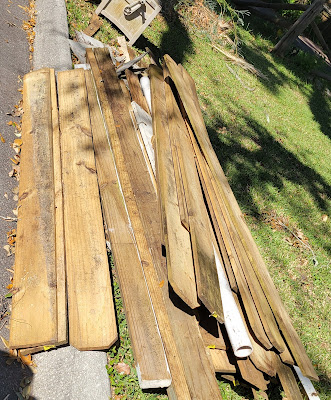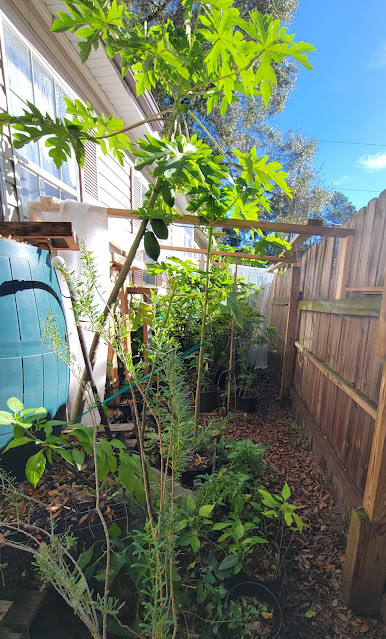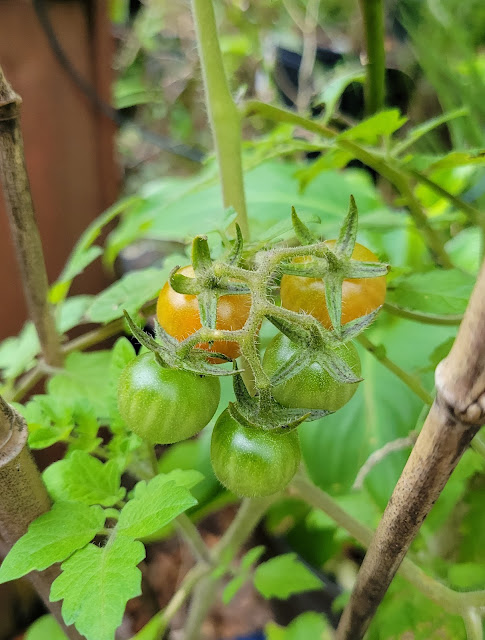- Get link
- X
- Other Apps
- Get link
- X
- Other Apps
So, it is forecasted to be a little chilly for Christmas here in Florida, which means that plant protection from frost is on all gardeners' minds, especially those of us who grow our own food.
From 60 degrees to 25 degrees Fahrenheit at night here in St. Augustine, the local gardeners are in prep mode, all while the kids are hoping for a white Christmas.
This fall we built our own greenhouse, a temporary Florida greenhouse for plant frost protection, but we weren't planning on using it until January or February. Thankfully it is already set up and ready to go, and all we need to do is move plants around and tighten it up.
When you live in zone 9a/9b, it is tempting to push the growing zones as we have very few nights with a chance of frost, and many tropical fruit trees will do fine down to 28 degrees, if they are mature and the trunk size are of a certain size. However, as a frugal gardener we start fruit trees from seeds, cuttings and buy them small, which is the reason why we expanded our temporary greenhouse this year to one with a DIY greenhouse with a more permanent skeleton.
Plant Protection from Frost:
Plant protection from frost in Florida does not mean that you need to go out and build a fancy greenhouse. As we explained in our build a cheap greenhouse post, it can be done on a budget as low as $12 - $20, and this simple set up is what we have been using for years in addition to the occasional cover with sheets.
- Consider how temporary you want your greenhouse
- How many plants do you have to protect?
- How big are the plants you want to protect from frost?
- How cold hardy are the plants and tees you're trying to protect?
- Do you have other protections against cold?
- Grow your plants close to your house for frost protection
- Create a microclimate by planting in between two homes, near structures, concrete walls and fences.
- Do you want to be able to stand and move around inside of your temporary frost protection?
- Easy access
- Access to a water source
- How can you source affordable materials?
- How will you attach your materials?
- Make sure you have something to keep the frost protection tied down in case of winds. We like to use bricks and heavy pots for this purpose.
- Make sure that the diy greenhouse is taller than your plants, so plants won't get burned during the daytime.
We've been collecting free wood from the side of the road and through Craigslist for a few months, and it is amazing what you can gather for free, if you just keep your eyes open, or you can join your local Buy Nothing Group as well.
 |
| Free wood |
Hubby's summer boss gifted a big clear tarp used for roofing for our project, but you can find it cheap at Lowe's, Amazon or Home Depot etc., or see the links below for other options. We got the 6 mil plastic, which should hold up for a while. If using plastic, only use it for one year or it will start disintegrating.
As with most building projects at our house, it is a shared project with vision, sketches and practicality in mind, and these husband-and-wife projects always test our communication skills, but in the end two heads are better than one, and sometimes the kids help out too.
Build Your Own Greenhouse Cheap:
- Get free materials or use secondhand materials
- Source materials on the side of the road, from friends and family, through Craigslist, Facebook marketplace and your local Buy Nothing group.
- Use plastic materials such as high density drop cloths, or for better quality use something like this 6 mil greenhouse plastic or this clear tarp with grommets. Plastic should only be used for a year, or it will start deteriorating.
- The best solution is if you can source plastic roofing panels for free, or want to invest into a more permanent soulution, these work well too.
- Measure, and double measure
- Sketch out your project.
- Lay out your materials before you start cutting.
The vision was a semi-permanent structure that will last a few years, where it is possible to cover up a large area in very little time for cold nights...and arctic fronts, while it should be easy to pull back and open up on sunny and rainy days.
For the past year or so, our old tomato garden at the side of the house has been replaced with a nursery for young tropical or semi-tropical trees and plants such as mango trees, Jamaican strawberry, cherry of the Rio Grande, jaboticaba, black sapote, white sapote, blackberry jam tree, a dragon fruit area with five different types, chaya, pigeon peas, salad trees and more.
The entire area is surrounded by passionfruit vines currently with fruit, and on the outside we've got peppers, tomatoes, papaya, herbs, moringa and Mexican sunflowers growing tall.
We had relocated any plants and trees that needed protection at around feezing, but with temperatures forecasted to reach as low as 25 degrees, we will pack the area even closer and add as many potted plants as possible including some of our tropical spinaches.
We're counting on the heat from the house to help aid in keeping the temperatures above freezing, the fence on the side to keep cold winds out, and gallon jugs filled 2/3 of the way with water placed inside the greenhouse and the closeness of the plants will also help keep them safe.
Now, we have lots of bananas that we are worried about, including our current double-blooming Dwarf Musa Cavendish and lots of papaya, but they will ultimately have to fend for themselves as they have done so many times before albeit never below 29 degrees.
We also have volunteer tomato plants and cranberry hibiscus that are currently setting fruit, and anything in pots will be relocated. The Cranberry hibiscus will usually die back and come again, but the seed pods are not quite mature enough to be picked yet, so the ones in pots will have to be protected.
It will be a test of the time for many Florida gardeners, especially those of us in North Florida, and we encourage everyone to prepare as much as possible.
How to Protect Plants from Freeze:
- Plant between structures
- Create microclimates
- Plant cold-sensitive plants in pots, so you can move plants to safety in case of frost.
- Plant cold-sensitive plants close to your home.
- Keep your tropical fruit trees pruned small.
- Take cuttings of plants and trees and start indoors for spring planting
- Cut down plants, if they get frost damage, but give them time to recover first.
- Water before and after a freeze
- Use bulb Christmas lights to warm up trees.
- Add bottles with water (not completely full) inside your frost protection
- A tree canopy can help protect the plants below it against frost and hard winds.
- Mulch well with woodchips, leaves and hay (make sure it is not contaminated).
- If you cover with plastic, make sure to remove the plastic in the morning to prevent burns.
- If your plants suffer frost damage, give them time to recover. This is especially important for bananas and papayas. We usually leave our bananas alone until the chance of frost has passed, and then we cut off damaged leaves, but we leave the trunks intact. For papayas, we will assess where the damage is, and cut off at an angle below the damaged trunk.
In addition to providing protection in the shape of plastic or sheets, we also encourage you to take cuttings to start inside. We will be taking cuttings of all of our tropical spinaches and starting them inside to make more plants and potentially to replace any plants lost to a freeze. As we like to experiment, we will make sure we leave some plants outside of the frost protection are, if we have more than one plant, just so we can see how these plants manage against the frost.
We are lazy gardeners, but we are not foolish gardeners, and while we aim not having to put any plants to bed, this year the reality is that many of our young fruit trees and tropical spinaches need protection, especially against an artic front with temperatures as low as 25 degrees, something we have not personally experienced with our tropical plants.
This year all I want for Christmas is for the temperatures to stay above 32 degrees F.
Learn more about growing your own food by reading more articles here at Dancing Treetops, browse our site and check out the labels in the top and side navigation bars.
Don't forget to follow us on social media,and reach out if you have any questions. You can find Dancing Treetops on Facebook, Instagram, You Tube and Pinterest.
- Get link
- X
- Other Apps
Popular Posts
Troy-Bilt Wood Chipper - Super Tomahawk = Our No. 1 Tool For Better Composting
We could not have gotten as far with our sustainable land clearing and composting, if it had not been for our power horse, our Troy-Bilt Super Tomahawk wood chipper with its 8 HP Briggs & Stratton motor. We purchased this 31+ year-old wood chipper off Craigslist for $200 about a year and a half ago, and it is still going strong. Troy-Bilt Super Tomahawk Wood Chipper
Zone 9A/9B Gardening Calendar - North East Florida Planting Schedule
Gardening in Florida is a very different experience than gardening in the rest of the country, and growing fruits and vegetables in North East Florida is a very different experience than gardening down south. It has taken us about five years to adjust to the zone 9 planting schedule, and while there are many zone 9 garden guides out there, we felt that there was a need for a simple, user friendly zone 9A/9B planting calendar.
How To Remove Palmetto Palms
If you have ever tried to remove a palmetto palm by cutting it down, you will likely have realized that removing palmettos is tricky. So, when we got ourselves a piece of land with about half an acre of these wonderful palmetto palms, also known as saw palmettos or shrub palmettos, we knew that we had a challenge on our hand.
Where To Find Free Nursery Pots and Planters
Every gardener needs something for their plants to grow in. Whether it is directly into the soil in your garden, into a garden bed, nursery pots, ceramic pots, terracotta pots, or if you get more creative, you need something for your plants to grow in. That's why we're always looking for free nursery pots and cheap planters.
How to Transplant a Banana Tree
Wondering how to transplant a banana tree? I know, it's not a tree, so wondering how to move a banana plant? Bananas are pretty easy to move, and they're pretty hardy too. The best time to transplant a banana plant is in the rain season, but I've planted and re-planted banana plants all year round, just remember to water well if it doesn't rain. Last year I planted a small ice cream banana pup in front of our home, but I was negligent in my research and didn't realize just how big it would get. I prefer moving banana trees in the rain season, but the leaves were getting too close to our power line, so it had to be moved. The roots of banana trees aren't very deep, and they will quickly re-establish, if you give them some love and water. The root ball of a 1 year old Grand Nain banana We've been preparing an area at The Land for banana babies, since we now have six different banana varieties at the house and these are beginning to give us pups. Today was th...
How to Grow Mulberry from Cuttings
Our favorite mulberry bush is in danger of eradication, so for the past year or so we have been growing mulberries from cuttings. Our children love eating fruit straight from the trees and bushes, and while we lose wild areas every day to construction and development in our community, we still have a few areas left untouched for now. Some mulberry trees are simply too tall for great mulberry picking, but this one mulberry bush is low and spread thick like a bush. Mulberries look similar to blackberries, but they are sweeter and juicier. They do not hold up well, which is why you will not find them in the stores, but we freeze any leftover mulberries to use in our weekly smoothies. Wild blackberries and wild mulberries We've taken cuttings three times from the mulberry bush. We waited until after fruiting last spring to take the first cutting, and the second time was about four months after fruiting. The third set of cuttings we took was in late winter, just as the mulberry bush had...
Save Your Papaya Trees After Cold Damage
Papayas are susceptible to high winds and freezes, but do not let that prevent you from growing papayas in zone 9a or 9b. In our experience, papayas are pretty cold hardy, but they do not like temperatures below freezing, especially not a sustained time with freezing temperatures. Temperatures below 40 degrees F/4 degrees C will make the papayas begin to look sad, but it is not until the temperatures hit freezing, that the papaya trees will sustain damage enough to kill the papayas. Last winter we had two quick freezes here in St. Augustine (growing zone 9a), and while our tallest papayas looked sad after the first freezing night, it was not until the second freeze that they were defeated. How to Save Papayas After a Freeze: After a freeze wait and see for a week or two to determine where you need to cut your papayas. If another freeze is imminent before your wait or see period is over, make the cut low, cover and protect. Look for new growth or a firmer trunk. Cut the papaya trun...
How To Make Permanent Plant Tags out of Recycled Plastic, Aluminum & Copper
We have lots of citrus trees in the garden, but until they produce fruits, they will be just that - citrus trees - because I have no clue what type they are, since most of my plant tags never held up. I've tried many different plant tags from chalk signs to plastic and the infamous popsicle stick. All failed the test of time, but when I started selling plants, I had to come up with some way to identify the plants and trees to make it easier for the customers. I wanted something that would last at least 6 months, could stand up against the weather, and I began looking for plastic plant tags. I had a hard time finding affordable, recycled plastic plant tags, so I decided to create my own permanent plant tags . (< see video) We've also begun a complete revamp of our front garden, which means more plants, and we've got lots of plants and trees growing for our future garden at The Land. For these plants, I wanted permanent plant labels that could contain both the common name ...
Finding Free Plants on Craigslist
If you are looking to add new plants to your garden, make sure to keep an eye out for free plants in the free section on Craigslist. We have picked up free plants a few times, when someone is clearing out their garden, and in return we make sure to post items as well. This morning I spotted a post for a free estate sale on Craigslist, and it included potted plants. It was in a fancy neighborhood by the beach, where an old house was being torn down to build a new huge one. We picked up several knick knacks such as plates, vases,paintings, lamps, a coat rack, a book shelf and more, and we also brought home as many big pots and plants as our mini van could fit. Free pots and plants These pots were the big ceramic kind that are not in our teacher's budget, and there were lots of different plants too. The plants need to be re-potted and re-nourished, but we've added some new plant species to our garden, which we will make sure to create more plants from trough seeds and ...
How To Grow Papaya From Seeds
Papaya is one of the easiest fruit trees to grow, if you provide them with the right conditions. Here in North East Florida we are in growing zone 9, and while papaya prefer warmer winters than we have here, we have still had great success. Eat a papaya, grow a papaya. We got the idea to grow papaya from seeds, when one of our children began suffering from constipation. The pediatrician suggested that we added papaya to the diet, because papaya is a diuretic. However, papaya can be expensive often costing $5 for a single fruit, and sometimes papaya can be hard to find at the store. For a frugal family of seven, this means papaya is a luxury, so we now make sure to have papaya trees of all sizes planted around the house. Each papaya fruit has a myriad of seeds, and they are so easy to start. Papaya does not like to be transplanted, although we have been able to do so with varying degrees of success, so plant the papaya directly in the soil outside. If you are in zone 10+, you ...




















Comments
Post a Comment